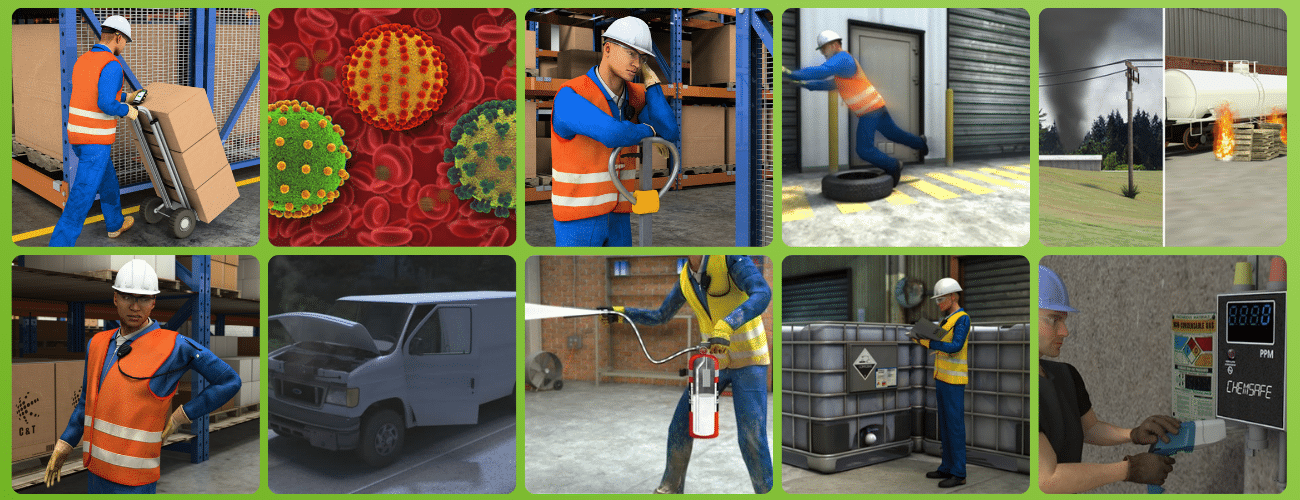April 10, 2024 8 min read

Top 10 Oil and Gas Training Courses to Include in Training Plans
Industry:
Solution:

In the evolving landscape of the Oil and Gas industry, ensuring the competence and readiness of personnel is key for success and safety. That’s why we’ve curated a list of the top ten oil and gas training courses from Vector Solutions eLearning libraries.
From foundational courses covering industry fundamentals to specialized training addressing safety, compliance, and operational excellence, this list of courses will enhance workforce capabilities, improve employee retention, and drive performance.
Top Oil and Gas Training Courses from Vector Solutions
This list of oil and gas training courses is based on course enrollments and completions from organizations we support in the industry. But remember that this is just a small sample of the courses we offer.
You can learn more about our oil and gas industry course offerings by downloading our free course catalog below.
1. Safe Use of Cell Phones (Microlearning)
Our Safe Use of Cell Phones microlearning course is the most completed course among a sample of our oil and gas customers.
About the Course: This course reviews the dangers of using cell phones while performing jobs in high-risk industries and how to avoid these risks.
Why it Matters: There are many industries where using a phone while working can be dangerous. In oil and gas, phones are not only distracting, they’re a fire risk.
About Vector Solutions’ Microlearning Courses.
Microlearning is training that is short-form and, therefore, quickly accessible to deskless workers. Breaking training into more manageable chunks improves knowledge retention and reduces how much time employees are taken away from their work.
2. Bloodborne Pathogens
This course on Bloodborne Pathogens is one of many safety eLearning offerings from Vector Solutions. These training libraries are award-winning with engaging 3D animations and designed by industry subject matter experts.
About the Course: This oil and gas training course goes into how pathogens can be transmitted via blood and other bodily fluids. It then teaches learners the simple actions they can take to drastically reduce their chance of exposure to bloodborne pathogens, including workplace practices, personal protective equipment, and more.
Why it Matters: In the Oil and Gas industry, workers may encounter situations where they are exposed to blood or other potentially infectious materials, whether during routine maintenance activities, emergency response situations, or accidents involving heavy machinery.
3. Fatigue Avoidance (Microlearning)
This microlearning course on Fatigue Avoidance is a critical safety topic in industrial and commercial work environments.
About the Course: Fatigue at work can be dangerous, especially when individuals are operating machinery and working in high-risk environments. This course reviews these dangers and how to avoid fatigue at work.
Why it Matters: Nearly 30% of Americans work outside of regular daytime hours, and 25% of workers work more than 40 hours a week. This can lead to more fatigue, which causes:
- Slowed reactions
- Reduced concentration/attention
- Limited short-term memory
- Impaired judgment

4. Slips, Trips, and Falls
Our Slips, Trips, and Falls course is one of the most completed Vector courses for industrial and commercial industries.
About the Course: In this course, employees are taught to identify hazards that cause slips, trips, and falls and the proper steps they must take to prevent injury. This course also covers how to administer first aid for fall injuries.
Why it Matters: Falls are the number one cause of work-related injuries, securing a spot as one of OSHA’s Focus Four. And workplaces in the oil and gas industry can be full of hazards that can increase the risk of this type of injury.
5. Emergency Action Plans
The fifth most completed Vector Solutions oil and gas course is Safety Management: Emergency Action Plans.
About the Course: This online course covers the importance of an emergency action plan and how to create one based on OSHA standards and industry best practices. This can serve as an introduction to emergency action plans or as a refresher course.
Why it Matters: Only 43% of workplaces have an emergency action plan in place. But preparedness can make all the difference in the event of an emergency. Train your employees in what these plans are, why they matter, and why they must be followed.
6. Back Safety (Microlearning)
This microlearning course on Back Safety is an important course for preventing ergonomic strain and injuries from improper lifting.
About the Course: This course discusses the factors that lead to back injuries and steps to avoid getting hurt.
Why it Matters: Back injuries are one of the leading causes of lost-time or restricted duty in the workplace. In oil and gas, lower back pain is fairly common. One NIH study found that nearly 30% of oil drilling workers report having lower back pain.

7. Driving Preparation
This Driving Preparation course is highly utilized because it covers so many of the basics for driving and operating vehicles for work—from maintenance and inspections to route planning.
About the Course: This course is a great introduction to preparing to drive, covering maintenance and common tools, emergency supplies, and more.
Why it Matters: Proper driving preparation can save employees time and your organization money. But, more importantly, this training can help save the lives of drivers, passengers, and pedestrians. With vehicle incidents accounting for 27% of all fatalities in oil and gas extraction, training employees on this topic couldn’t be more important.
8. Fire Extinguisher Safety
This course on Fire Extinguisher Safety is a key part of an oil and gas company’s safety curriculum.
About the Course: This course goes into detail about the fire tetrahedron, the types of fires that occur in the workplace, as well as how and when to use a fire extinguisher.
Why it Matters: Fire and explosions are responsible for 15% of all injuries in oilfields, making it the third most frequent risk. Training employees in what to do in the event of a fire, including when to evacuate, is critical to reducing injuries and saving lives.
9. Hazard Communication GHS
This course, Hazard Communication GHS, is essential for any workplace using or around hazardous materials and chemicals. So, naturally, it’s an important part of oil and gas industry training.
About the Course: This course dives into the labeling requirements of chemicals, aligning with the 2021 Hazard Communication “HazCom” standard and the Globally Harmonized System (GHS).
Why it Matters: GHS will increase the quality and consistency of the information you’re providing to employees. Educating employees on this topic will help them more safely handle and store hazardous substances, keeping themselves and their fellow employees safe.
10. Hydrogen Sulfide Awareness
The last topic in our most completed oil and gas training courses is Hydrogen Sulfide Awareness.
About the Course: This online course provides learners with critical information about odorless Hydrogen Sulfide (H2S), including the risks and side effects. Further, this course helps employees detect H2S and educates them on the steps they should take.
Why it Matters: Hydrogen Sulfide is a very dangerous gas because it’s highly flammable and toxic even at low concentrations. OSHA reports that this gas killed 46 people between 2011 and 2017.

What to Look for in Online Oil and Gas Courses
When selecting online oil and gas courses, several key factors should be considered to ensure they meet the specific needs and requirements of the industry. Here are some essential criteria to look for:
- Engaging Content. Effective online courses should feature engaging content that captures learners’ attention and improves learning outcomes. Look for courses that incorporate case studies, 3D animation, and microlearning options for optimal engagement.
- Accurate and Compliant. Oil and gas training courses must be based on up-to-date industry standards, regulations, and best practices, including those set forth by regulatory agencies such as OSHA and the EPA.
- Comprehensive Coverage. The best eLearning providers should offer training on a wide range of relevant topics. This includes safety, operational procedures, industry and role-specific skills, and even professional development.
By considering these factors when evaluating online oil and gas training courses, companies can ensure their employees receive high-quality training that meets industry standards, enhances skills and knowledge, and contributes to a culture of safety and excellence in the workplace.
The Power of Online Oil and Gas Training Courses
Online training has revolutionized the way companies deliver education and development programs to their workforce. Online training offers:
- Unparalleled flexibility. Using an online training vendor enables companies to provide more updated content to employees in real-time, ensuring that they stay abreast of the latest industry standards, regulations, and best practices.
- Accessibility. Employees can access training materials at their convenience and from the work site. Online training is often also offered in multiple languages, making it more accessible to a diverse workforce.
- Scalability. Provide training to employees regardless of where they work and what they do.
- Cost savings. Save money by eliminating the need for traditional classroom-based training sessions, including travel, instructor fees, and printed materials.
Using online oil and gas training courses not only enhances employee knowledge and skills but also helps organizations maintain compliance and adapt to rapidly evolving business environments.
One of the key advantages of online training is its ability to complement traditional in-person training methods through blended learning approaches. By incorporating online modules into their training programs, companies can optimize the effectiveness of in-person sessions by focusing on company-specific topics, hands-on activities, and interactive discussions. This blended approach allows employees to benefit from the flexibility and self-paced learning offered by online courses while still receiving personalized instruction and guidance during face-to-face interactions.
Blended Learning Solutions Guide
Create a modern training strategy that meets the needs of your workforce
Download Guide
Want to learn more about how Vector Solutions supports oil and gas companies like you? Request a demo today.







